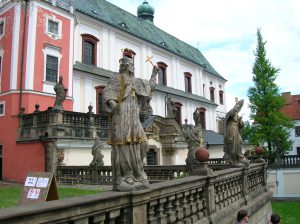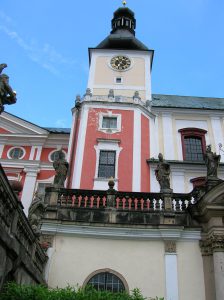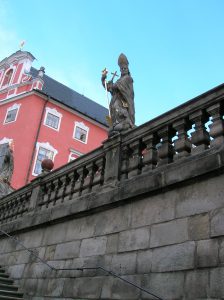Broumov Monastery
 Broumov Monastery, situated near the Polish border of northeastern Bohemia in a town founded during the 13th century, offers the visitor a plethora of sights. It boasts of statues of saints on the balustrade of the terrace. A determined Saint Prokop, clad in flapping drapery, proudly grips a cross. The masterful Baroque architecture by the Dientzenhofer father-and-son duo also enthralls. The interior is filled with frescoes and more. A copy of the Shroud of Turin is also one of the main attractions.
Broumov Monastery, situated near the Polish border of northeastern Bohemia in a town founded during the 13th century, offers the visitor a plethora of sights. It boasts of statues of saints on the balustrade of the terrace. A determined Saint Prokop, clad in flapping drapery, proudly grips a cross. The masterful Baroque architecture by the Dientzenhofer father-and-son duo also enthralls. The interior is filled with frescoes and more. A copy of the Shroud of Turin is also one of the main attractions.
History
During 1306 the monastery, run by Benedictines, became a grammar school that Czech personalities such as Arnošt of Pardubice, who served as the first Prague Archbishop in the middle of the 14th century, attended. Other prominent graduates include writer Alois Jirásek and the first Czechoslovak Minister of Finance, Alois Rašín. While the school was closed in the 15th century due to the Hussite wars that ravaged the land, it was reopened in 1624 after the uprising of the Bohemian Estates from 1618 to 1620 during the Thirty Years’ War. (Holy Roman Emperor Matthias appointed Ferdinand as his heir, which caused a major fuss among the Protestants because Ferdinand abhorred Protestantism.) In the early 17th century Protestants constructed their own church near the Lower Gate, causing much tension. Even though Emperor Ferdinand II ordered it to be shut down and put some rebels in prison, the church remained open. This Catholic-Protestant conflict in Broumov helped trigger the Prague defenestration of vice-governors on May 23, 1618, when the two representatives Ferdinand had sent to oversee the Czech government at Prague Castle were pushed out a window along with the secretary. This marked the Second Defenestration of Prague and instigated the Bohemian Revolt.
The directors of the Bohemian Estates confiscated the monastery, which was purchased by citizens of Broumov. The complex was returned to the Benedictines after the Battle of White Mountain in 1620, when the Catholics, led by Holy Roman Emperor Ferdinand II’s army, defeated the Protestant Bohemians. The monastery was in ruins but was restored. The school was closed in 1939 when the Nazis controlled the monastery. The Benedictines got it back from 1945 to 1948, but then the Communists took over, and during 1950 it became an internment camp for monks. The monastery was not returned to the Benedictines again until 1990.
The church
 Originally Gothic, the church of Saint Vojtěch (Adalbert) took on a Baroque appearance thanks to Italian builder Martin Allio and the Dientzenhofer team of father Kryštof and son Kilián Ignáz during the 17th and 18th centuries. The Dietzenhofers remodeled the other monastery buildings in Baroque style as well. A pink fresco-filled ceiling with stucco décor shows the death of Saint Vojtěch, among other scenes. In the Saint Benedict chapel, white angels flutter amidst spiraling pink columns. Reliquaries of Saint Klement and Saint Vincent also adorn the church. The oldest painting, hailing from 1609, shows the Holy Family fleeing from Egypt. The organ dates from 1689. In the choir carved wooden benches boast of gold decoration while the frescoes above display scenes such as “The Last Supper”. Flanked by Saint Václav (Wenceslas) and Saint John of Nepomuk, Saint Vojtěch stands proudly in the middle of the main altar that hails from 1706.
Originally Gothic, the church of Saint Vojtěch (Adalbert) took on a Baroque appearance thanks to Italian builder Martin Allio and the Dientzenhofer team of father Kryštof and son Kilián Ignáz during the 17th and 18th centuries. The Dietzenhofers remodeled the other monastery buildings in Baroque style as well. A pink fresco-filled ceiling with stucco décor shows the death of Saint Vojtěch, among other scenes. In the Saint Benedict chapel, white angels flutter amidst spiraling pink columns. Reliquaries of Saint Klement and Saint Vincent also adorn the church. The oldest painting, hailing from 1609, shows the Holy Family fleeing from Egypt. The organ dates from 1689. In the choir carved wooden benches boast of gold decoration while the frescoes above display scenes such as “The Last Supper”. Flanked by Saint Václav (Wenceslas) and Saint John of Nepomuk, Saint Vojtěch stands proudly in the middle of the main altar that hails from 1706.
The library
Originally the monastery contained three libraries with a total of 67,000 books, but now only one remains, and the number of books has dwindled to 17,000. During the totalitarian regime, some books were thrown out the window, others went to Prague and still, others were stolen as the Communists tried to cancel out Czech culture. The collection flaunts reading material written in Latin, Spanish and French as well as Czech and deals with subjects such as law and history. Seven volumes of The Old Testament make up the heaviest books, each weighing 20 kilograms. Portraits decorate the balustrades, and frescoes adorn the ceiling. Illustrated manuscripts are featured in display cases.
The refectory and The Shroud of Turin
The first-floor refectory features vestments – the oldest is red with gold decoration, dating from the 17th century – and paintings of scenes from Benedictine monasteries. But the treasure in the room is one of 40 copies of the Shroud of Turin, discovered in the Saint Cross chapel in 1999. Supposedly, Jesus Christ was wrapped in the original shroud after his body was taken down from the cross. Those who believe in its authenticity argue that an impression of a coin circulated at the time of Jesus of Nazareth’s death is shown in one of the eyes. Originally kept in Constantinople, it has been stored in Turin since the 16th century. Made in 1651, this copy – the only one found north of the Alps – was a gift to Broumov Abbot Sobek of Bílenberk from Turin Bishop Bergirius. The shroud features a brown impression of Christ’s body with a light outline.
The charts
Large historical charts are on display in the corridor. The one that denotes events from the 19th-century marks that the cholera epidemic ravaged the region in 1836. A board from 1812 shows that hop-plant was the most expensive product of that year. The oldest chart is written in distinguished Latin script, dating from 1542, restored in 1811.
The museum
 The monastery also features a museum illustrating more than 700 years of the region’s history. Gothic, Renaissance and Baroque objects are just a few of the attractions located in six halls. Weapons, folk nativity scenes, shooting targets and regional folk costumes round out the permanent exhibition while there are temporary exhibits as well. Perhaps most striking is the poster announcing that this region of a German-speaking majority called the Sudetenland had been incorporated into the Third Reich in 1938, as a result of the Munich Agreement. After World War II, Czechoslovak President Edvard Beneš signed the so-called Beneš decrees, which expelled the Germans from the former Sudetenland. The visitor sees the brutality of 20th-century history that seeped through the region.
The monastery also features a museum illustrating more than 700 years of the region’s history. Gothic, Renaissance and Baroque objects are just a few of the attractions located in six halls. Weapons, folk nativity scenes, shooting targets and regional folk costumes round out the permanent exhibition while there are temporary exhibits as well. Perhaps most striking is the poster announcing that this region of a German-speaking majority called the Sudetenland had been incorporated into the Third Reich in 1938, as a result of the Munich Agreement. After World War II, Czechoslovak President Edvard Beneš signed the so-called Beneš decrees, which expelled the Germans from the former Sudetenland. The visitor sees the brutality of 20th-century history that seeped through the region.
The mummies
As of the summer of 2012, 32 mummies from Vamberk are stored in the crypt, 20 of which are on display. The surprisingly small 17th and 18th-century townspeople lay in open coffins. The mummies have been in Broumov since 2000 due to restoration work in Vamberk and are slated to return to their original location at some yet undesignated time.




